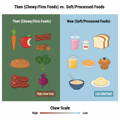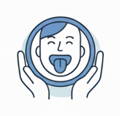Beyond Braces: The Rise of Orofacial Myofunctional Therapy in Modern Dentistry
Orofacial Myofunctional Therapy (OMT) is becoming increasingly recognized as a vital component within the broader landscape of healthcare, particularly as the understanding of the oral-systemic link deepens. It addresses the functional aspect of the oral and facial muscles, which can significantly impact dental health, facial development, breathing, and even sleep.
— Cleveland Clinic
“Orofacial Myofunctional Therapy is a key player in preventive dentistry and airway health. When done properly, it can improve everything from orthodontic outcomes to sleep quality.”
— Stanford Sleep Medicine Center
Modern Diets, Modern Airways, & Modern Jaw Problems
Why Chewing Matters (Then vs. Now)
Before the Industrial Revolution,our diets were tougher and required far more chewing. That sustained effort strengthened the jaw muscles and stimulated broader jaw and palate growth. Today’s softer, processed foods demand less chewing, which can contribute to weaker, imbalanced muscles, narrower palates and jaws, smaller airways, and crowded teeth.
Orofacial Myofunctional Therapy helps retrain, tone, and balance the muscles of the tongue, lips, and jaw—guiding healthier growth in children while bones are still malleable, and improving muscle support for the jaw joint in adults during both rest and activity.

How Orofacial Myofunctional Therapy Works
OMT is essentially like physical therapy for the muscles of the mouth, jaw, airway, face, head, and neck.
Normalize Resting Posture:
This is crucial. Ideally, the tongue should rest gently suctioned to the roof of the mouth (palate), with lips closed and teeth slightly apart. OMT helps achieve this throughout rest, activity, day and night.
Correct Swallowing Patterns:
An incorrect swallowing pattern (e.g., tongue thrusting) where the tongue pushes against or between the teeth can contribute to orthodontic issues and speech problems. OMT retrains the tongue to swallow and rest correctly.
Improve Muscle Tone and Coordination:
Exercises strengthen, relax, coordinate, and balance the muscles involved in chewing, swallowing, speaking, breathing, and sleeping.
Establish Nasal Breathing:
Many people habitually breathe through their mouths, which can negatively impact facial development, dental alignment, and overall health. OMT exercises help promote and train nasal breathing, by decreasing congestion, and opening the airway.
Eliminate Harmful Oral Habits:
Habits like thumb sucking, prolonged pacifier use, nail biting, or lip biting can all contribute to orofacial myofunctional disorders (OMDs). OMT can help you eliminate these harmful habits.
It Complements and Enhances Dental Work
If you’re undergoing orthodontics (like Invisalign or braces), we help:
Guide proper tongue posture to avoid pushing teeth out of place, eliminate harmful oral habits, and balance the muscles supporting the jaw. Reinforcing results so your treatment lasts.
In some children, reduce the need for orthodontics altogether by correcting functional issues early.
These exercises are typically simple but require consistent practice over several months to a year to re-pattern muscle memory and create lasting change.
How Orofacial Myofunctional Therapy is Growing and Its Role in Dental and Health Care
OMT is experiencing significant growth in dental care for several reasons:

1. Non-Surgical Approach to Oral Health: As dentistry moves towards a more natural understanding of health, OMT fits perfectly. It addresses underlying muscular and functional issues that can manifest as dental problems, rather than just treating the symptoms. Dentists and orthodontists are increasingly recognizing that addressing these root causes leads to more stable and long-lasting treatment outcomes.
2. Orthodontic Outcomes and Relapse Prevention:
○ Improved Treatment Effectiveness: Improper tongue posture or mouth breathing can exert forces that hinder orthodontic tooth movement or even cause relapse after braces are removed. OMT, when integrated with orthodontic treatment (e.g., clear aligners or traditional braces), helps stabilize the bite and improve the long-term success of orthodontic corrections.
○ Reduced Need for Interventions: In some cases, especially in children, early OMT can guide proper facial and jaw development, potentially reducing the severity of malocclusion and the need for extensive orthodontic treatment later.
3. Sleep-Disordered Breathing (SDB) and Sleep Apnea: There's a growing awareness of the strong link between oral posture, airway development, and sleep.
○ Adjunctive Therapy for Sleep Apnea: OMT is increasingly recommended as an adjunct therapy for mild to moderate obstructive sleep apnea (OSA) and snoring. By strengthening the tongue and throat muscles, OMT can help maintain airway patency during sleep, potentially reducing the severity of OSA and improving sleep quality. It can also enhance compliance with other treatments like CPAP or oral appliances.
○ Screening and Early Intervention: Dentists are on the front lines of identifying signs of SDB, and OMT provides a non-invasive early intervention strategy.
4. Orofacial Pain: Dysfunctional oral muscles can contribute to temporomandibular joint (TMJ) pain and related issues like teeth grinding (bruxism) and clenching. OMT can help restore proper muscle function/balance and alleviate these symptoms.
5. Speech Clarity: Many speech impediments, such as lisps or difficulty with certain sounds, are directly related to improper tongue and lip positioning, toning, and flexibility. OMT, often in collaboration with speech-language pathologists, can significantly improve speech articulation.
6. Preventive Dentistry: OMT aligns perfectly with the growing focus on preventive care. By addressing oral habits and muscular dysfunctions early on, it can prevent a cascade of dental and health problems, including:
○ Malocclusion (misaligned teeth)
○ Narrow palates
○ Tooth decay (due to altered saliva flow, mouth breathing, or tongue flexibility)
○ Gum disease
○ Facial aesthetic imbalances
Interdisciplinary Collaboration: The effectiveness of OMT often relies on a team approach, involving dentists, orthodontists, ENT specialists, speech-language pathologists, and even lactation consultants (for infants). This collaborative model is a growing trend in healthcare, and OMT fosters it.
Take home message
In summary, Orofacial Myofunctional Therapy is gaining traction because it offers a foundational, functional solution to many oral health and systemic issues that traditional health approaches might only address symptomatically. Its integration into dental practices represents a shift towards a more comprehensive and preventive model of care, recognizing the interconnectedness of oral and overall health.
How Oral-Facial Advantage Therapists do it
Assessment
Airway screening, oral habit analysis, muscle tone tests, photos & measurements.

Personalized exercises
One-on-one coaching and exercise plan.
Habit reinforcement
Bi-Weekly check‑ins, daytime and sleep‑therapy strategies.



